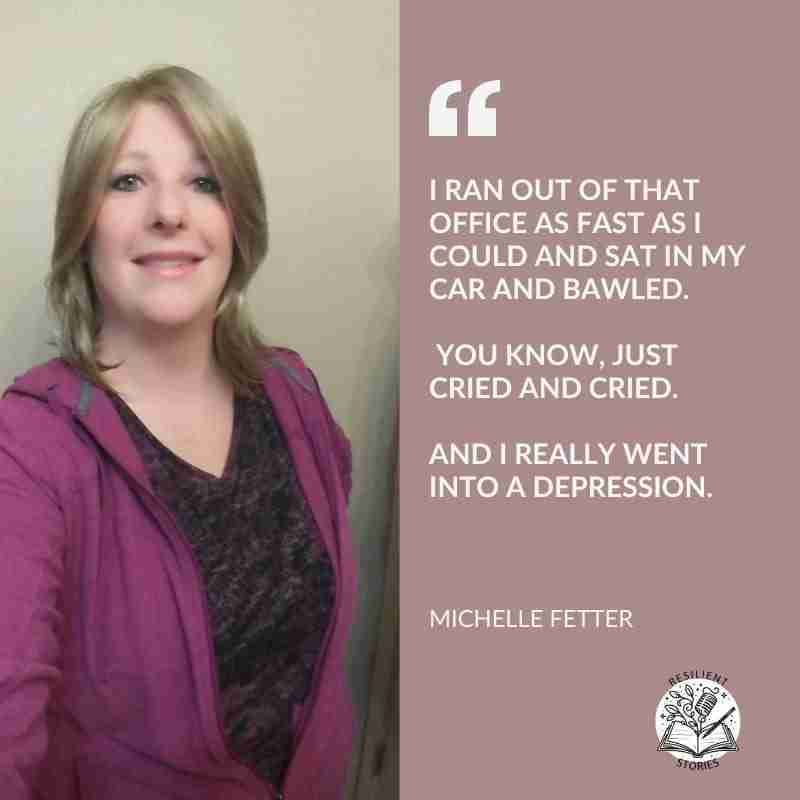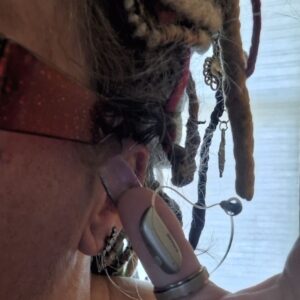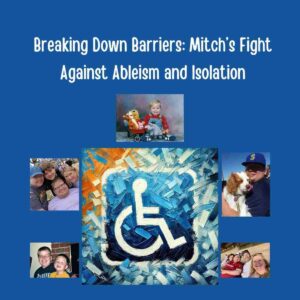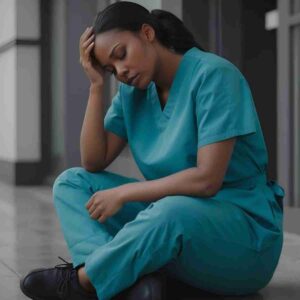At nineteen, Michelle was a positive and confident young woman. She was so proud of her favorite physical feature—long, flowing strawberry-blonde hair. She hadn’t heard of the term Alopecia Areata before, but it would change her life.
She planned to grow her hair down to her waist, weaving it into her identity, a symbol of beauty and confidence. But life had other plans. One day, while playing with her hair at work, Michelle felt a small bald spot.

It was covered up, hidden from sight, but it left her shaken. She asked a coworker, who was also a hairdresser, to take a look. “There’s nothing red, nothing pulled,” she was told. But those words didn’t ease the mounting dread.
The hairdresser mentioned something Michelle had never heard of before: Alopecia Areata. This was 1985, a time when little was known about the condition.
The word itself felt foreign and terrifying, something she couldn’t fully understand. Alopecia? Hair loss? The thought was as surreal as it was horrifying.
Her first appointment with a dermatologist shattered her spirit. He coldly confirmed what the hairdresser suspected but offered no real comfort. “Just go buy a wig, like the old ladies do,” he said.
In that moment, Michelle’s world broke open.
She was 19—how could she just accept this? The trip home was a blur of tears, and what followed was a rapid descent into despair. Within a month, all of her hair was gone.
The Ripple Effect: Losing Hair, Losing Herself
As the days passed and her hair fell out in clumps, Michelle’s confidence unraveled with it. The unpredictability of further hair loss because of alopecia areata added to her anxiety.
Washing her hair became an unbearable task; she’d braid it before bed, only to wake up and feel the strands scattered on her pillow.
Each lost strand felt like losing a piece of herself.
The mirror, once a place of self-assurance, became a battleground.
She was no longer the vibrant, carefree girl she recognized. She felt broken.
The Challenges of Wig Shopping: A Costly Battle with Hair Loss
To recapture some of herself, she and her mother went wig shopping. However, she already had the thought in her head that this was something “old ladies” needed.

The journey to find a wig was an emotional rollercoaster. Michelle’s first attempt, a human hair wig her mother purchased for $500, was a devastating disappointment.
Not only was the wig the wrong color—far from her natural strawberry blonde—but after trying to dye it, the hair itself fell out.
The whole experience left her feeling even more defeated, realizing that not only was her hair gone, but finding a suitable replacement came with challenges and heartbreak.
Wigs weren’t just a cosmetic solution for Michelle; they were her armor. Along with her fake lashes, because those also fell out, along with all her body hair.
However, even that armor had its price—both financial and emotional.
Wearing a wig every day took a toll, especially in the summer, when the heat would make her head unbearably hot, often causing sores from the constant friction.
Unlike people who might wear a wig occasionally for fun, Michelle wore hers daily, as a necessity to feel “normal.”
Alopecia Areata and Its Impact on Her Mental Health
It wasn’t just the hair loss—it was the way it seeped into everything. The way her friendships shifted, how she pushed people away. Even Rob, her boyfriend of two years, who had always been her rock, couldn’t reach her.
“You’re still beautiful,” her friends would say, but Michelle couldn’t hear them. No matter how much they reassured her, the mirror told a different story. Her anger grew, not just at her hair, but at everyone around her.
Her relationships with her friends, even Rob, strained under the weight of her despair.
Michelle’s job was another casualty of her condition. She loved working at Mayflower of China, a Chinese restaurant, but once her hair loss became noticeable, she couldn’t face going in.
Her mother had to call in for her and explain that Michelle wouldn’t be back for a while. The fear of being seen bald and vulnerable kept her hidden, unable to return to normal life until she could find a wig to feel comfortable again.
This period of withdrawal amplified her feelings of hopelessness.
In her darkest moment, it all came crashing down. She picked a fight with Rob one night, pushing him to the brink. He could no longer take the toxicity that had consumed their relationship.
He tried to be patient, to love her through the anger, but even love has its limits. The fight ended with Michelle threatening her own life, grabbing a kitchen knife and holding it to her wrist, more out of desperation than intent.
Rob, seeing the extent of her pain, gently took the knife from her and called her mother, telling her that Michelle needed help.
A Step Towards Healing From Alopecia Areata Totalis
It was her mother who introduced her to Emotions Anonymous, a support group that became a lifeline. There, surrounded by others dealing with their struggles, Michelle found perspective.

She realized that though her pain was real; she wasn’t alone. She learned that some battles are worth fighting, and others—like hair loss—need acceptance. Slowly, piece by piece, she began to rebuild herself.
Her journey to acceptance wasn’t linear, and it certainly wasn’t quick. Even after finding a wig that helped her feel more like herself, Michelle’s emotional scars took longer to heal.
But with time, she came to understand that her beauty was not defined by her hair or lack of it—it was something deeper, something internal. It was in her resilience, her strength, and her ability to endure.
Attending Emotions Anonymous, Michelle found not just community, but a new perspective on her suffering. Listening to the stories of others—people dealing with abusive relationships, cancer, and even the loss of children—made her realize, “It’s not that bad.”
Though her pain was valid, she learned to contextualize it within the broader spectrum of human suffering. This newfound perspective gave her strength, allowing her to see that while hair loss had taken so much from her, she still had the power to reclaim her life.
She also learned the importance of picking her battles—something as simple as recognizing that not having to shave her legs was a small, unexpected benefit. This shift in mindset toward gratitude helped her focus on what she could control, rather than what she had lost.
Causes and Triggers
Alopecia Areata is a complex condition, and its exact causes and triggers remain somewhat of a mystery.
However, research has shed light on several contributing factors. Genetics plays a significant role; if you have a family history of hair loss, you are more likely to develop Alopecia Areata.
This type of hair loss is also linked to other autoimmune diseases, such as thyroid disease, type 1 diabetes, and vitiligo, suggesting a common underlying immune system dysfunction.
Hormonal imbalances can also trigger Alopecia Areata. Changes during pregnancy or menopause, for instance, may lead to sudden hair loss.
Stress is another potential trigger, as it can exacerbate the condition in some individuals. Environmental factors, such as exposure to certain chemicals in hair dyes or styling products, may also contribute to developing Alopecia Areata.
Understanding these triggers can help in managing and potentially mitigating the impact of this autoimmune disease.
Alopecia Areata: Treatment Options for Bald Spots
Alopecia Areata is unpredictable, and the treatments can vary depending on the individual, especially considering the various factors contributing to hair loss, such as immune system responses, genetic predispositions, and environmental triggers.
In Michelle’s case, the early treatments she tried, including steroid creams, were painful and ineffective. The creams, meant to stimulate hair growth by reactivating dormant hair follicles, only caused irritation and discomfort.

Some treatments, like steroid injections or topical immunotherapy, can help others with Alopecia Areata, but they didn’t work for Michelle, whose condition had progressed too far.
Wigs and cosmetic options became Michelle’s most practical solution. She eventually found natural and comfortable wigs, but even this had its challenges.
Good quality wigs can be expensive—sometimes as much as $1,000 or more—and insurance often considers them a “cosmetic” need, refusing coverage.
Michelle’s doctor even tried to submit a claim by calling it a “cranial prosthetic,” but the insurance company still denied it.
For those with Alopecia Areata, wigs are often more than just a cosmetic accessory—they’re a lifeline to normalcy, self-esteem, and confidence.
More recently, there have been advances in treatment options. JAK inhibitors, a newer class of drugs, have shown promise in some cases, helping to regrow hair by targeting the immune response that attacks hair follicles.
These advances offer hope that hair can grow back, particularly in cases where hair loss occurred within the last year. However, these treatments can be costly and aren’t always accessible.
For many people like Michelle, finding the right treatment can be a long and frustrating journey.
Emotional Support and Coping
Living with Alopecia Areata can be emotionally taxing, but having a robust support system can make a world of difference.
Joining a support group can provide a sense of community and understanding, as connecting with others who share similar experiences can be incredibly comforting.
Counseling is another valuable resource; a therapist can help navigate the feelings of anxiety, depression, and low self-esteem that often accompany hair loss.
Practicing self-care is crucial. Activities like yoga, meditation, or deep breathing exercises can promote relaxation and reduce stress.
Focusing on positive body image is also essential; try to emphasize your strengths and qualities beyond your hair.
Educating yourself about Alopecia Areata and its treatment options can empower you, making you feel more in control of your condition.
Remember, emotional well-being is just as important as physical health when managing Alopecia Areata.
Alopecia Areata: Symptoms of Alopecia Areata
Alopecia Areata often starts subtly, with symptoms of alopecia areata, as it did for Michelle. It begins with a small bald patch, which can be easy to miss or cover-up. In Michelle’s case, within a month, that small patch spread rapidly, and her hair was gone.
The condition occurs when the immune system mistakenly attacks the hair follicles, leading to hair loss, which can happen on the scalp or across the entire body.
This autoimmune disease is characterized by patchy hair loss that can occur on the scalp and other areas of the body. The extent of the hair loss can vary:
Alopecia Areata: Hair loss occurs in small, round patches on the scalp or other parts of the body.
Alopecia Totalis: Complete loss of hair on the scalp, which Michelle eventually experienced. Approximately 5% of individuals with alopecia areata experience the totalis form.
Alopecia Universalis: Loss of all hair on the body, including eyebrows, eyelashes, and other areas. Alopecia areata universalis is a rare form of hair loss, accounting for approximately 1% of cases.
For Michelle, her condition progressed to Alopecia Universalis. She lost all the hair on her scalp and body, which required her to wear wigs and false eyelashes to feel more like herself.
Though the condition is not physically painful, the emotional toll it takes can be profound. Many people, like Michelle, feel a deep loss of self-confidence, battling feelings of isolation and shame.
Yet, through her journey, Michelle learned that her beauty and worth transcended her hair—something she wishes everyone with Alopecia Areata could one day realize.
Managing Daily Life
Alopecia Areata can impact various aspects of daily life, but there are ways to manage these challenges effectively. Wearing a wig or hairpiece can boost confidence in social situations, helping you feel more like yourself.
Protecting your scalp from the sun with a broad-spectrum sunscreen of at least SPF 30 is essential, especially if you have significant hair loss.
Taking care of your skin is also important. Use gentle skincare products and avoid harsh chemicals that could irritate your skin.
Staying active through physical activities like walking, running, or swimming can improve your overall well-being.
Connecting with friends, family, and support groups can provide emotional support and help you navigate the ups and downs of living with Alopecia Areata.
By incorporating these strategies, you can maintain a fulfilling and active lifestyle despite the challenges of hair loss.
Advances in Treatment
The quest for effective treatments for Alopecia Areata is ongoing, with researchers making significant strides. One promising development is the use of JAK inhibitors.
These medications work by blocking the activity of immune cells that attack hair follicles, thereby helping to stimulate hair growth.
Alopecia is not just a concern for women. Male pattern baldness, known as androgenetic alopecia, is often passed down through families and shrinks hair follicles. Medications like Propecia, have helped to reduce the level of DHT exposure to the hair follicles, which means the hair can grow back thicker.
Stem cell therapy is another exciting area of research, with the potential to promote hair growth by regenerating damaged hair follicles.
Low-level laser therapy (LLLT) is gaining attention for its ability to stimulate hair growth using low-level lasers or light-emitting devices. This non-invasive treatment has shown promise in promoting hair growth in individuals with Alopecia Areata.
Gene therapy is also being explored as a potential treatment, aiming to use genes to stimulate hair growth. These advances offer hope for more effective ways to treat Alopecia Areata and help individuals regain their hair and confidence.
By understanding the causes, seeking emotional support, managing daily life effectively, and staying informed about treatment advances, those living with Alopecia Areata can navigate their journey with resilience and hope.
Michelle’s story is a testament to the strength and beauty that lies within, regardless of hair loss.
Beyond Hair: A Journey of Self-Acceptance with Alopecia Areata
Michelle’s story is not just about hair loss; it’s about losing oneself and finding the strength to rebuild.
Her journey with Alopecia Areata tested her in unimaginable ways, but through support, self-acceptance, and time, she learned to redefine her beauty.
She hopes that others—whether struggling with Alopecia or any other form of personal hardship—can find solace in knowing that they are more than the sum of their struggles.

True beauty, she believes, is found in resilience, in how we rise after we fall.
Have you or someone you love experienced Alopecia Areata?
Share your story with us in the comment section below!


























0 Comments